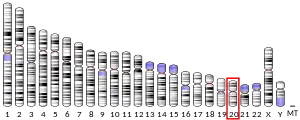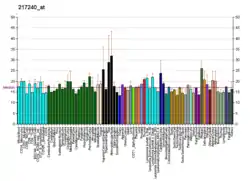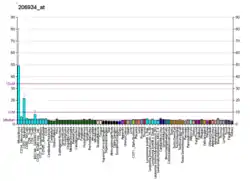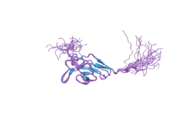SIRPB1
Signal-regulatory protein beta-1 is a protein that in humans is encoded by the SIRPB1 gene.[5][6][7] SIRPB1 has also recently been designated CD172B (cluster of differentiation 172B).
| SIRPB1 | |||||||||||||||||||||||||||||||||||||||||||||||||||
|---|---|---|---|---|---|---|---|---|---|---|---|---|---|---|---|---|---|---|---|---|---|---|---|---|---|---|---|---|---|---|---|---|---|---|---|---|---|---|---|---|---|---|---|---|---|---|---|---|---|---|---|
 | |||||||||||||||||||||||||||||||||||||||||||||||||||
| |||||||||||||||||||||||||||||||||||||||||||||||||||
| Identifiers | |||||||||||||||||||||||||||||||||||||||||||||||||||
| Aliases | SIRPB1, CD172b, SIRP-BETA-1, signal regulatory protein beta 1 | ||||||||||||||||||||||||||||||||||||||||||||||||||
| External IDs | OMIM: 603889 MGI: 3779828 HomoloGene: 82993 GeneCards: SIRPB1 | ||||||||||||||||||||||||||||||||||||||||||||||||||
| |||||||||||||||||||||||||||||||||||||||||||||||||||
| |||||||||||||||||||||||||||||||||||||||||||||||||||
| |||||||||||||||||||||||||||||||||||||||||||||||||||
| |||||||||||||||||||||||||||||||||||||||||||||||||||
| |||||||||||||||||||||||||||||||||||||||||||||||||||
| Wikidata | |||||||||||||||||||||||||||||||||||||||||||||||||||
| |||||||||||||||||||||||||||||||||||||||||||||||||||
The protein encoded by this gene is a member of the signal-regulatory-protein (SIRP) family, and also belongs to the immunoglobulin superfamily. SIRP family members are receptor-type transmembrane glycoproteins known to be involved in the negative regulation of receptor tyrosine kinase-coupled signaling processes. This protein was found to interact with TYROBP/DAP12, a protein bearing immunoreceptor tyrosine-based activation motifs. This protein was also reported to participate in the recruitment of tyrosine kinase SYK. Alternatively spliced transcript variants have been found for this gene.[7]
References
- GRCh38: Ensembl release 89: ENSG00000101307 - Ensembl, May 2017
- GRCm38: Ensembl release 89: ENSMUSG00000095028 - Ensembl, May 2017
- "Human PubMed Reference:". National Center for Biotechnology Information, U.S. National Library of Medicine.
- "Mouse PubMed Reference:". National Center for Biotechnology Information, U.S. National Library of Medicine.
- Kharitonenkov A; Chen Z; Sures I; Wang H; Schilling J; Ullrich A (April 1997). "A family of proteins that inhibit signalling through tyrosine kinase receptors". Nature. 386 (6621): 181–6. Bibcode:1997Natur.386..181K. doi:10.1038/386181a0. PMID 9062191. S2CID 4259314.
- van den Berg TK; van Beek EM; Buhring HJ; Colonna M; Hamaguchi M; Howard CJ; Kasuga M; Liu Y; Matozaki T; Neel BG; Parkos CA; Sano S; Vignery A; Vivier E; Wright M; Zawatzky R; Barclay AN (December 2005). "A nomenclature for signal regulatory protein family members". J Immunol. 175 (12): 7788–9. doi:10.4049/jimmunol.175.12.7788. PMID 16339511.
- "Entrez Gene: SIRPB1 signal-regulatory protein beta 1".
- Dietrich, J; Cella M; Seiffert M; Bühring H J; Colonna M (January 2000). "Cutting edge: signal-regulatory protein beta 1 is a DAP12-associated activating receptor expressed in myeloid cells". J. Immunol. UNITED STATES. 164 (1): 9–12. doi:10.4049/jimmunol.164.1.9. ISSN 0022-1767. PMID 10604985.
- Tomasello, E; Cant C; Bühring H J; Vély F; André P; Seiffert M; Ullrich A; Vivier E (August 2000). "Association of signal-regulatory proteins beta with KARAP/DAP-12". Eur. J. Immunol. GERMANY. 30 (8): 2147–56. doi:10.1002/1521-4141(2000)30:8<2147::AID-IMMU2147>3.0.CO;2-1. ISSN 0014-2980. PMID 10940905.
Further reading
- Dietrich J, Cella M, Seiffert M, et al. (2000). "Cutting edge: signal-regulatory protein beta 1 is a DAP12-associated activating receptor expressed in myeloid cells". J. Immunol. 164 (1): 9–12. doi:10.4049/jimmunol.164.1.9. PMID 10604985.
- Tomasello E, Cant C, Bühring HJ, et al. (2000). "Association of signal-regulatory proteins beta with KARAP/DAP-12". Eur. J. Immunol. 30 (8): 2147–56. doi:10.1002/1521-4141(2000)30:8<2147::AID-IMMU2147>3.0.CO;2-1. PMID 10940905.
- Deloukas P, Matthews LH, Ashurst J, et al. (2002). "The DNA sequence and comparative analysis of human chromosome 20". Nature. 414 (6866): 865–71. Bibcode:2001Natur.414..865D. doi:10.1038/414865a. PMID 11780052.
- Cannon JP; Haire RN; Litman GW (2002). "Identification of diversified genes that contain immunoglobulin-like variable regions in a protochordate". Nat. Immunol. 3 (12): 1200–7. doi:10.1038/ni849. PMID 12415263. S2CID 19367972.
- Strausberg RL, Feingold EA, Grouse LH, et al. (2003). "Generation and initial analysis of more than 15,000 full-length human and mouse cDNA sequences". Proc. Natl. Acad. Sci. U.S.A. 99 (26): 16899–903. Bibcode:2002PNAS...9916899M. doi:10.1073/pnas.242603899. PMC 139241. PMID 12477932.
- Suzuki Y, Yamashita R, Shirota M, et al. (2004). "Sequence Comparison of Human and Mouse Genes Reveals a Homologous Block Structure in the Promoter Regions". Genome Res. 14 (9): 1711–8. doi:10.1101/gr.2435604. PMC 515316. PMID 15342556.
- Gerhard DS, Wagner L, Feingold EA, et al. (2004). "The Status, Quality, and Expansion of the NIH Full-Length cDNA Project: The Mammalian Gene Collection (MGC)". Genome Res. 14 (10B): 2121–7. doi:10.1101/gr.2596504. PMC 528928. PMID 15489334.
- Liu Y, Soto I, Tong Q, et al. (2006). "SIRPbeta1 is expressed as a disulfide-linked homodimer in leukocytes and positively regulates neutrophil transepithelial migration". J. Biol. Chem. 280 (43): 36132–40. doi:10.1074/jbc.M506419200. PMID 16081415.
- Liu T, Qian WJ, Gritsenko MA, et al. (2006). "Human Plasma N-Glycoproteome Analysis by Immunoaffinity Subtraction, Hydrazide Chemistry, and Mass Spectrometry". J. Proteome Res. 4 (6): 2070–80. doi:10.1021/pr0502065. PMC 1850943. PMID 16335952.
- Laplana M, Royo JL, Aluja A, López R, Heine-Sunyer H, Fibla J (September 2014). "SIRPB1 copy‐number polymorphism as candidate quantitative trait locus for impulsive‐disinhibited personality". Genes, Brain and Behavior. 13 (7): 653–62. doi:10.1111/gbb.12154. hdl:10486/667487. PMID 25039969.
External links
- SIRPB1 human gene location in the UCSC Genome Browser.
- SIRPB1 human gene details in the UCSC Genome Browser.
This article incorporates text from the United States National Library of Medicine, which is in the public domain.






